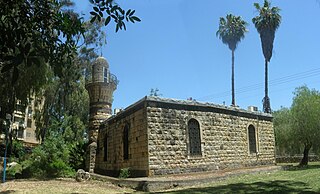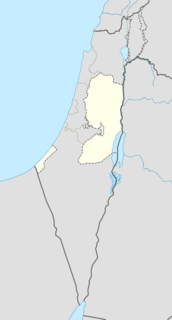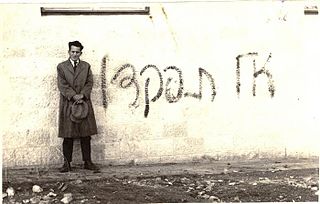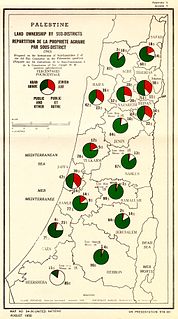

The Survey of Palestine was a two volume survey of Mandatory Palestine prepared between December 1945 and March 1946, as evidence for the Anglo-American Committee of Inquiry. [1] A supplement was published in June 1947. [2]


The Survey of Palestine was a two volume survey of Mandatory Palestine prepared between December 1945 and March 1946, as evidence for the Anglo-American Committee of Inquiry. [1] A supplement was published in June 1947. [2]

The White Paper of 1939 was a policy paper issued by the British government, led by Neville Chamberlain, in response to the 1936–1939 Arab revolt in Palestine. After its formal approval in the House of Commons on 23 May 1939, it acted as the governing policy for Mandatory Palestine from 1939 to the 1948 British departure. After the war, the Mandate was referred to the United Nations.

The Anglo-American Committee of Inquiry was a joint British and American committee assembled in Washington, D.C. on 4 January 1946. The committee was tasked to examine political, economic and social conditions in Mandatory Palestine as they bear upon the problem of Jewish immigration and settlement therein and the well-being of the peoples now living therein; to consult representatives of Arabs and Jews, and to make other recommendations 'as may be necessary' to for ad interim handling of these problems as well as for their permanent solution. The report, entitled "Report of the Anglo-American Committee of Enquiry Regarding the Problems of European Jewry and Palestine", was published in Lausanne on 20 April 1946.

The Jewish Settlement Police (JSP) were a division of the Notrim established in Mandatory Palestine in 1936, during the 1936-39 Arab revolt.
The Palestinian Arab Party was a political party in Palestine established by the influential Husayni family in May 1935. Jamal al-Husayni was the founder and chairman. Emil Ghuri was elected general secretary until the end of the British Mandate in 1947. Other leaders of the party included Saed al-dean Al-Aref, Rafiq al-Tamimi, Tawfiq al-Husayni, Anwar al-Khatib, Kamil al-Dajani, and Yusuf Sahyun.
The National Bloc was a Nablus-based party established in 1935 in the British Mandate for Palestine by Abd al-Latif Salah, a lawyer and former official in the Ottoman Senate at Istanbul. Salah generally took an anti-Husayni stance.
The National Defense Party was founded by Raghib al-Nashashibi in the British Mandate of Palestine in December 1934.
The Youth Congress Party was a Palestinian political party that was established by Yaqub al-Ghusayn. It was formed in 1932 in the British Mandate of Palestine and quickly grew to become the largest nationalist association of the early 1930s, counting several thousand members by mid-1934 in branches across the country. The party rejected British rule and was generally pro-Husayni.
The Reform Party was established by Husayn al-Khalidi in Palestine on 23 June 1935.

Husayn Fakhri al-Khalidi was mayor of Jerusalem from 1934 to 1937.

Al-Khalisa was a Palestinian Arab village situated on a low hill on the northwestern edge of the Hula Valley of over 1,800 located 28 kilometers (17 mi) north of Safad. It was depopulated in the 1948 Palestine war.

Bani Suheila is a Palestinian town in the southern Gaza Strip part of the Khan Yunis Governorate.

The Districts and Sub-districts of Mandatory Palestine formed the first and second levels of administrative division and existed through the whole era of Mandatory Palestine, namely from 1920 to 1948. The number and territorial extent of the districts varied over time, as did their subdivision into sub-districts.
Operation Gideon was a Haganah offensive launched in the closing days of the British Mandate in Palestine, as part of the 1947–48 Civil War in Mandatory Palestine. Its objectives were to capture Beisan, clear the surrounding villages and bedouin camps and block one of the possible entry routes for Transjordanian forces. It was part of Plan Dalet. The operation was carried out by the Golani brigade between 10–15 May 1948. Avraham Yoffe commanded the battalion that captured Beisan. The 1947 UN Partition Plan allocated Beisan and most of its district to the proposed Jewish state. It is possible that Irgun units were involved in parts of the operation. Following the operation, the town formally surrendered with most of its residents fleeing. Most Arab Christians relocated to Nazareth. A ma'abarah inhabited mainly by North African immigrants was also erected in Beit She'an, and it later became a development town.

The 1931 census of Palestine was the second census carried out by the authorities of the British Mandate for Palestine. It was carried out on 18 November 1931 under the direction of Major E. Mills after the 1922 census of Palestine. No further census was conducted in Palestine by the British administration.

The Ramle Subdistrict was one of the subdistricts of Mandatory Palestine. It was part of Lydda District of the British Mandate of Palestine. The sub-district's main city was Ramle. Its total population in 1944 was estimated at 123,490, of which 88,560 were Muslims; 29,420 were Jews; and 5,500 were Christians. A number of Palestinian Arab villages in the subdistrict were depopulated during the 1948 Palestine War, both by Jewish forces prior to the Israeli declaration of independence and after by Israeli forces. Following the war the area that had made up Ramla Subdistrict became a part of Israel's Central District, being mostly subdivided between a newly created Ramla Subdistrict and Rehovot Subdistrict.

Village Statistics, 1945 was a joint survey work prepared by the Government Office of Statistics and the Department of Lands of the British Mandate Government for the Anglo-American Committee of Inquiry on Palestine which acted in early 1946. The data were calculated as of April 1, 1945, and was later published and also served the UNSCOP committee that operated in 1947.

Mandatory Palestine was a geopolitical entity established between 1920 and 1948 in the region of Palestine under the terms of the League of Nations Mandate for Palestine.
John Macqueen was a Scottish doctor and medical administrator working in Palestine during the British Mandate.

The Morrison–Grady Plan, also known as the Morrison Plan or the Provincial Autonomy Plan was a joint Anglo-American plan for the creation of a unitary federal trusteeship in Mandatory Palestine, announced on 31 July 1946.

The London Conference of 1946–1947, which took place between September 1946 and February 1947, was called by the British Government of Clement Attlee to resolve the future governance of Palestine and negotiate an end of the Mandate. It was scheduled following an Arab request after the April 1946 Anglo-American Committee of Inquiry report.